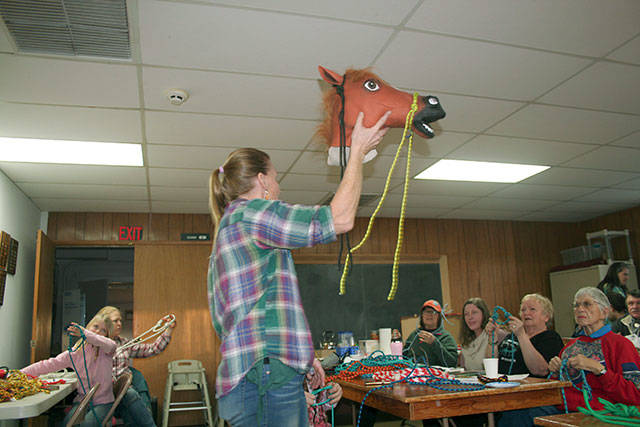“HOW BIG IS your wingspan?” Lisa Preston asked the audience as she stretched her arms out side-to-side.
I didn’t know mine. Do you know yours?
“Mine is five feet wide,” Lisa said, explaining, “if you know your wingspan it makes it really easy to measure out how much rope you’ll need to make a bridle.”
Ah, so there was a method to her madness, or antics I should say. I was at the Sequim Valley Grange with about 30 other people who were eager to learn about making our own bitless bridles courtesy of the Back Country Horsemen’s Peninsula Chapter.
The ever-bubbly Lisa was there to share her knowledge with us, with crafting principles based on her 2013 book, “Bitless Bridles: How to Make and Use Inexpensive Bit-Free Bosals, Chin-Slips, Cross-Jaws, Indian Hackamores, Halters, Neck Loops, Side-Pulls and More.”
She even brought along a big rubber horse head to demonstrate her techniques on.
“First, I’d like you to measure out and cut 20 feet of rope,” she said.
Using her wingspan as a guide she took one end from a large bundle of rope and proceeded to measure out approximately 20 feet. She cut it, divided it by two and cut it again. Then used a lighter to melt the ends to prevent unraveling.
“For the neatest burned ends slide back the outer a bit to expose the inner mantle. Cut the inner core about ¼ inch back, give it a quick burn and then slide the outer sheath over the core and give it a quick burn. This will give the ends a neater, more tapered look that’s less likely to unravel,” she said.
Waiting until we all had our two 10-foot strips of rope, she told us to take one and showed us how to make the top section that goes over the ears, the beginnings of a Side-Pull bridle.
“Really this is the length and start you need to make almost every type of headstall,” she said.
OK, admittedly as a group, myself included, it took us awhile to figure out which knot went where and which direction each end of the rope should go, but we did get there.
Most of us brought our own rope, specifically a type of kernmantle cord or climbing rope. Kernmantle rope is constructed with its interior core protected by a woven exterior sheath. The core fibers provide the tensile strength of the rope, while the sheath protects the core from abrasion during use.
Do not use cheap polypropylene rope because it lacks the inner and outer kern.
Not necessary, but certainly helpful hardware to have on hand are 1-inch metal rings, trigger snaps and quick release snaps.
“When making your own creations you can mix different colors and even materials,” she said. “I like to incorporate tubular webbing to soften some areas, such as over the pole.”
Someone in the audience asked her if it had to be tubular.
“Yes, because you need to be able to thread the cord through it.”
Another asked if there was anyplace local to buy it.
“I know Swains in Port Angeles carries it,” she said, adding, “This is a really inexpensive way to try out different styles of bridles and hackamores on your horse to see which one works best. 100 feet of ¼ inch rope will make five bridles.”
She mentioned we’d want to use a thicker rope, or even flat webbing for the reins; whatever feels best in our hands.
By the end we all had made at least one bridle. We had to wait to get home to try it on our horses to make the final adjustments for a custom fit though.
When the class was over I had a chance to talk more with Lisa, who was my neighbor when I lived on Olson Road in Sequim. Oh how I do miss riding for miles through those wooded trails and logging roads in what I called “my big backyard,” otherwise known as the Cassidy Creek Dept of Natural Resources land.
Lisa still rides there of course. I mentioned noticing she was suddenly selling household items on Facebook, and asked if she was moving or just getting rid of things she no longer needed.
“Well, perhaps a little bit of both,” she replied.
She didn’t want to come out and say for sure she and her husband, Barry, were moving, only that they were thinking of a move to Arizona, “We haven’t really decided yet.”
Just three days later while volunteering at a McDonald’s McTakeover for my nephew’s school, Helen Haller, I was approached by another former Olson Road neighbor, real estate agent Michelle Ridgeway, who told me Lisa had just listed her house with her and had already received an offer. I don’t know if an offer’s been accepted yet, but obviously I wish only the best for Lisa and Barry’s new adventure! They will be missed by the many friends they’ve made during their twenty years in Sequim.
In the meantime check out Lisa’s web site at lisapreston.com to see her latest books, including “Dead Blow,” “The Clincher” and the soon-to-be released “Forging Fire,” all from her Horseshoer’s Mystery series.
Also coming in 2020 will be another non-fiction book titled “Alternative Treatments for Animals.”
________
Karen Griffiths’ column, Peninsula Horseplay, appears the second and fourth Sunday of each month.
If you have a horse event, clinic or seminar you would like listed, please email Griffiths at kbg@olympus.net at least two weeks in advance. You can also call her at 360-460-6299.

